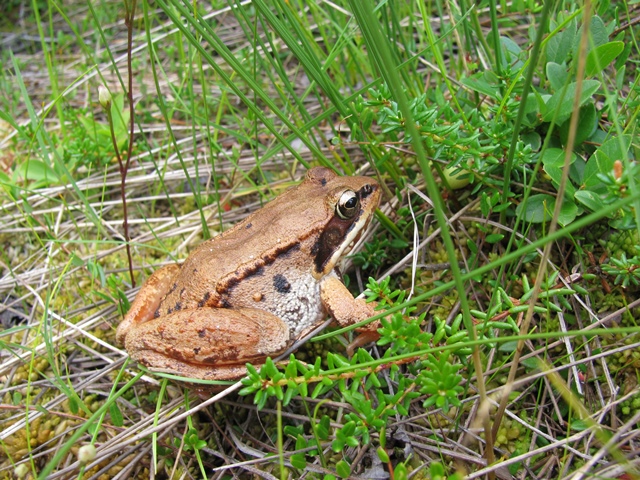
Warmer water and minute traces of copper increase predation of Wood Frogs. Photo by Steve Faccio
Alaska’s hardy wood frogs, like other amphibians around North America, have been plagued by a mysterious disorder that is deforming and killing them off.
As reported by Yereth Rosen in various spots in South-central and eastern Interior Alaska, clusters of frogs are emerging from ponds with misshapen or missing limbs, abnormal eyes or other physical oddities. Now, laboratory evidence is backing up some theories about the cause.
A study by researchers from Alaska Pacific University, the U.S. Fish and Wildlife Service and the University of California, Davis, found that in warmer water that contains minute traces of copper, dragonfly larvae attack wood frog tadpoles more quickly and frequently.
The study, published in the journal Ecosphere, supports two hypotheses about wood frog deformities in Alaska: one concerning warmer water temperatures that are hastening predation by tadpole-biting dragonfly larvae and the other concerning chemical contamination.
The laboratory study used water that was warmed up to 71.6 degrees Fahrenheit — a temperature consistent with the warming that is happening in the wild and with what is forecast for the future, said co-author Mari Reeves, a U.S. Fish and Wildlife Service ecologist who has devoted several years to studying Alaska’s wood frogs.
What she, lead author Tess Hayden of APU and other scientists found was that, in a controlled laboratory setting, dragonfly larvae attack wood frog tadpoles 30 minutes earlier and three times as often in warmer, copper-tainted water than in clear and cooler water, which was down to 62.6 degrees.
Attacks by dragonfly larvae have been hypothesized to cause limb amputations for the frogs that grow from the tadpoles; warmer waters are believed to be encouraging a proliferation of dragonflies and their larvae. But chemical contamination is also believed to be a contributing factor.
In the laboratory study, tadpoles in the clean water spent more time swimming around in deeper areas; those in the water with copper spent more time being stationary near the surface, making them more vulnerable to attack, Reeves said.
Her hypothesis about that particular behavior is that copper, even in the minute amounts used in the study, interferes with frogs’ ability to get oxygen — just as copper contamination is known to interfere with the functioning of fish gills and the ability of fish to get oxygen.
The level of copper in the water used in the laboratory study — 1.85 parts per billion — was minute, Reeves said, considering that 1 part per billion is like “one sheet of toilet paper in a roll of toilet paper that stretches from New York to London.”
And it was less than half the 4 parts per billion copper level found in Anchorage ponds and wetlands that are used to treat road drainage, she said.
The copper is believed to be coming from tiny particles that wear off on car brake pads. Because of the known risks to wildlife from copper, some states are considering bans on the use of copper in brake pads, Reeves said.
